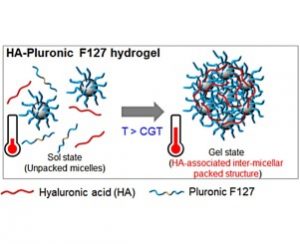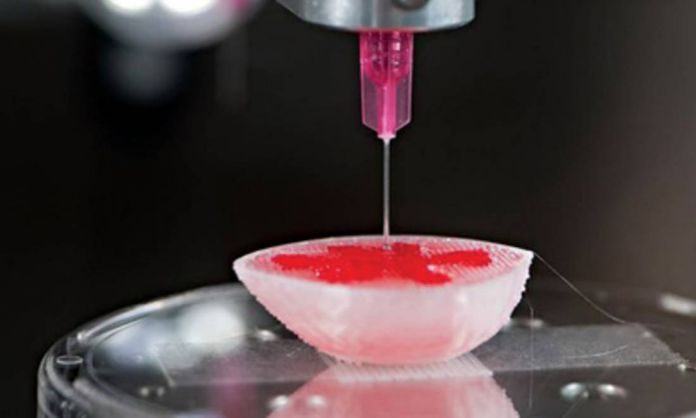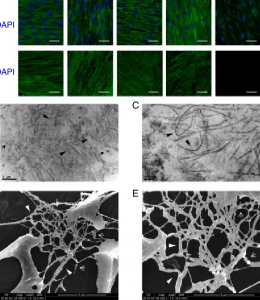Bioink refers to substances made of living cells that can be used for 3D printing of complex tissue models. Bioinks are materials that mimic an extracellular matrix environment to support the adhesion, proliferation, and differentiation of living cells. Bioinks distinguish themselves from traditional biomaterials such as hydrogels, polymer networks, and foam scaffolds due to their ability to be deposited as filaments during an additive manufacturing process. They can be alginate-based, gelatin based, pluronics, and decellularized ECM-based.
Alginate is a naturally derived biopolymer from the cell wall of brown algae that has been widely used as a biomaterial. Alginates are particularly suitable for bioprinting due to their mild cross-linking conditions via incorporation of divalent ions such as calcium. These materials have been adopted as bioinks through increasing their viscosity. Additionally, these alginate-based bioinks can be blended with other materials such as nanocellulose for application in tissues such as cartilage.
Gelatin has been widely utilized as a biomaterial for engineered tissues. The formation of gelatin scaffolds is dictated by the physical chain entanglements of the material which forms a gel at low temperatures. However, at physiological temperatures (body temperature), the viscosity of gelatin drops significantly. Methacrylation of gelatin is a common approach for the fabrication of gelatin scaffolds that can be printed and maintain shape fidelity at physiological temperature. Methacrylation is important for restorative material properties and bioengineering.
Decellularized Extracellular Matrix
Decellularized extracellular matrix based bioinks can be derived from almost any mammalian tissue. However, most organs such as heart, muscle, cartilage, bone, and fat are decellularized, lyophilized, and pulverized, to create a soluble matrix that can then be formed into gels. These bioinks have advantages over other materials due to their derivation from mature tissue. These materials consist of a complex mixture of decellularized extracellular matrix and proteins specific to their tissue origin. Therefore, dECM-derived bioinks are particularly tailored to provide tissue-specific cues to cells. Often these bioinks are cross-linked through thermal gelation or chemical cross-linking such as through the use of riboflavin.
Pluronics have been utilized in printing application due to their unique gelation properties. Below physiological temperatures, the pluronics exhibit low viscosity. However, at physiological temperatures, the pluronics form a gel. A more permanent pluronic-based network can be formed through the modification of the pluronic chain with acrylate groups that may be chemically cross-linked.
So, I have done my obligatory duty of informing you with new material. However, I am not here to only be a scribe with no life. Let us get a little more excited about this article. Is it not wild to think that most of the materials used in bioinks are readily synthesizable? I could order all of this and make some in my own home if I wanted. I also think the material properties discussed are so vast and interesting. Just having a little bit of organic chemistry as well as biochemistry knowledge leads a user to fully enjoy and soak in the importance of biomaterials. I believe it is necessary for me to at some point show some live demonstrations of synthesis with these materials. Talking gets boring after a while, but practical work gets exciting.
Subscribe to Our Email Newsletter
Stay up-to-date on all the latest news from the 3D printing industry and receive information and offers from third party vendors.
You May Also Like
Gorilla Sports GE’s First 3D Printed Titanium Cast
How do you help a gorilla with a broken arm? Sounds like the start of a bad joke a zookeeper might tell, but it’s an actual dilemma recently faced by...
Nylon 3D Printed Parts Made More Functional with Coatings & Colors
Parts 3D printed from polyamide (PA, Nylon) 12 using powder bed fusion (PBF) are a mainstay in the additive manufacturing (AM) industry. While post-finishing processes have improved the porosity of...
$25M to Back Sintavia’s Largest Expansion of Metal 3D Printing Capacity Since 2019
Sintavia, the digital manufacturing company specializing in mission-critical parts for strategic sectors, announced a $25 million investment to increase its production capacity, the largest expansion to its operations since 2019....
Velo3D Initiates Public Offering in a Bid to Strengthen Financial Foundations and Drive Future Growth
Velo3D (NYSE: VLD) has been among a number of publicly traded 3D printing firms that have attempted to weather the current macroeconomic climate. After posting a challenging financial report for 2023,...

































